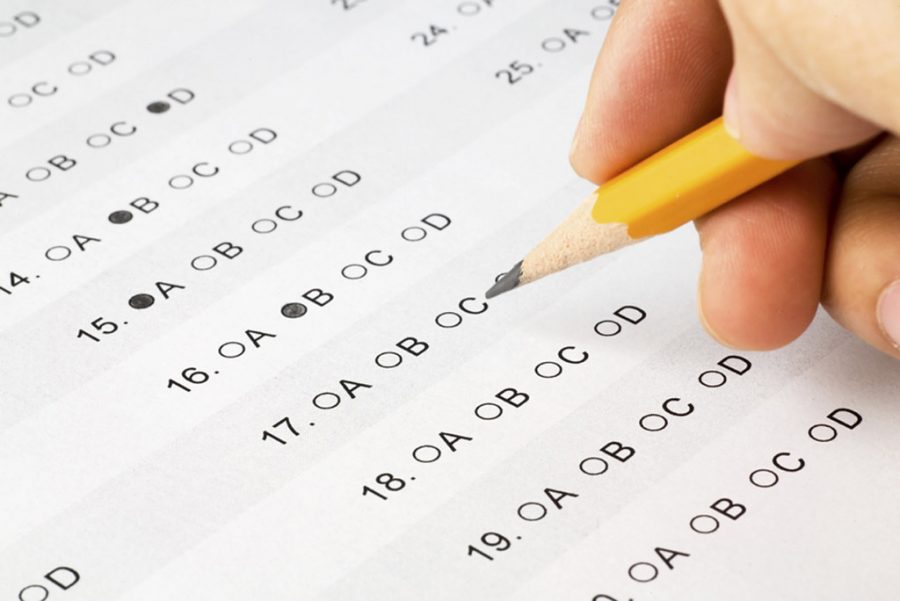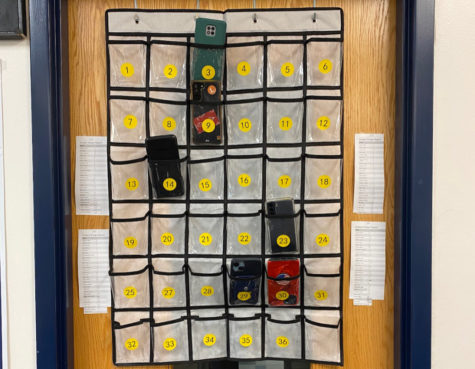Exams Are In: Teachers’ Thoughts Behind Them
The new policy for exams is as follows according to the student handbook:
Final Exam Grading Policy: Credit is granted based upon receiving a passing (D- or higher) final grade in a class. Final grades are computed based upon a combination of marking period grades plus the final exam, which could be between 5-20% of the total grade.
In recent years, the Chelsea School District has begun to take a different approach to the long-time standard of holding final exams. Instead of the traditional fifty-question multiple choice packet, teachers might choose to have students complete a final project or activity. Including changes to the formats that exams can take, the point percentage has also been subject to changes. The highlighted area (above) is what changed this past year: the final exam’s percentage is no longer a mandatory 20% of a student’s grade.
“End-of-term exams provide students and staff feedback on a student’s proficiency in a course and this information allows a student to identify strength areas and areas for further curriculum exploration,” CHS Principal Doctor Nick Angel said. “The sliding scale of percentage allows for staff to create performance-based assessments and flexibility surrounding how students demonstrate their understanding of content. We know longer use only 20% multiple-choice exams to measure student proficiency.”
Despite the new opportunity for flexibility, some teachers are opting for the 20% option as it allows teachers to test their given curriculum to its fullest potential and challenge students to summarize what they have learned over the course of a trimester.
“I teach chemistry and physics—both of these courses weigh exams at 20%,” Melissa Taylor said. “This gives students a great opportunity to show all of their learning over the entire term and ensure they have a strong understanding of the content for the next term of the course.”
However, others believe that in order to prepare students for college, a student’s final grades should be impacted by a larger percentage of their final grade.
“I usually weigh them as 20% of the grade—I’d rate it higher, but that’s the highest allowed,” math teacher Lonnie Mitchell said. “I want to prepare the students for college and almost all colleges give finals for math classes. In some cases, the final score is 50% of the grade in college.”
Giving tests with a larger percentage also gives students more of an opportunity to change their grade in a class whereas lower percentages cannot.
“I am very content with the 20%, I really believe there needs to be a culminating experience that’s important and raises stress levels a little bit,” math teacher Chris Orlandi said. “When you start talking about things like 10%, you can’t move the needle. The kid that has an 89% almost has no reason to study because you really can’t get the 90%. That kid with an 89% also doesn’t have to worry because really, it would take something like a 59% for it to go down.”
In terms of the freshman class, the freshman teachers have collectively agreed to make their exam percentage 10%. The argument for a lower percentage is based on the fact that freshmen are still adjusting to the high school environment.
“The argument on behalf of many teachers that are worried about freshmen would be that [giving a 10% exam] gets kids used to life at the high school,” Orlandi said. “I’m of the opinion that we should throw them in the water. They’re gonna start swimming, everybody will do fine. I can understand both sides of the aisle though.”
With the new policy, teachers have more room to test students’ knowledge in the way they prefer, from final projects to short answer questions, while leaving students with a better grasp of the content.
“With the new flexibility, teachers are able to structure their exams to ensure they are reflections of student learning and relevant skills in their content area,” Taylor said. “I appreciate the end-of-term exams because they are the culmination of the learning from the entire term and allow me and the student to see their understanding in a big picture way.”
Some teachers have decided to structure their tests with a combination of multiple different kinds of test questions.
“[My] exams are a combination of short answer, problem-solving, multiple choice—all of which are formats we practice throughout the term that are relevant to science,” Taylor explained. “We sometimes include a lab component, as well.”
In the art room, students have the opportunity to make something they enjoy while enhancing their grades.
“Students work on this project over the course of a few weeks and focus on big ideas and open-ended themes,” art teacher Claire Popovich explained. “It gives artists the chance to showcase their skills that they have learned throughout the trimester and apply it to a project of their choice. Students are generally excited to complete their final projects as it acts as a celebration of their skills.”
Some courses such as math can only use problem-based questions to fully cover the content learned rather than projects or multiple choice.
“Written well, it should give me an idea of the mastery of the content,” Orlandi said. “Why I don’t like a project is that a lot of times that project isn’t fully comprehensive. A lot of teachers tend to give multiple choices. I think for math, multiple choice makes no sense whatsoever, because when you get it wrong, I have no idea why you got it wrong.”
After the exams are in, teachers can reflect on the trimester and their students’ growth.
“Looking at their first project to their last project makes their progress as an artist very evident,” Popovich said. “I think it’s helpful from the teacher’s perspective to see those skills develop. I think even if it wasn’t called an exam, we would do a final project in the art room. I see it as we learned the skills now let’s do something with it.”
Administering an exam allows teachers to plan ahead for next year and give them a point to go back and expand on in the next trimester if needed.
“[Exams are a] useful tool in thinking about preparation for the next term of the course–for example, the Physics A Exam giving students a sense of how ‘ready’ they are for Physics B since the content is cumulative,” Taylor said. “Another added benefit is giving students practice with exams since most science courses after high school, community colleges, universities, will assess in this way.”
Exams allow teachers to prepare students for college, teaching them how to prepare and challenge themselves for tests that will have a larger impact on their grades.
“They benefit the student by preparing them for college which is part of our role as high school math teachers,” Mitchell said. “They also set students up for success in future terms and prove to the teacher the student has fully understood the math-not just remembered the day before a chapter test and then forgot it. I find math finals are extremely necessary for the end of a trimester.”
Overall, exams are important and good for both teachers and students as they help track student progress over the trimester.
“[Exams] are a good thing because I think everything you do that’s significant should have a closure experience,” Orlandi said. “You go to college—there’s going to be something at the end, and we are doing students a disservice in my opinion if we eliminate that. So for that reason, I think they’re good.”

Sonja is a junior and this is her third year writing for the Bleu Print. She is dedicated to her violin and plays in the Chelsea Orchestra program as well...










